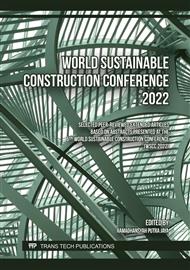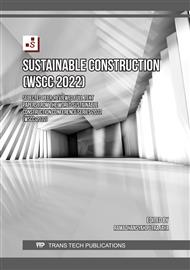[1]
M.A. Kuddus, E. Tynan, E. McBryde, Urbanization: a problem for the rich and the poor?, Public Health Rev. 41, 1 (2020).
DOI: 10.1186/s40985-019-0116-0
Google Scholar
[2]
H.I. Vazhuthi, A. Kumar, Causes and impacts of urban floods in Indian cities: A review, International Journal on Emerging Technologies. 11(4) (2020) 140-147.
Google Scholar
[3]
N.S. Romali, N. Othman, N. Ramli, The application of green roof for stormwater quantity and quality improvement, IOP Conference Series: Earth and Environmental Science. (2021).
DOI: 10.1088/1755-1315/682/1/012029
Google Scholar
[4]
Z. Ismail, H. A. Aziz, N. M. Nasir, M. Z. M. Taib, Obstacles to adopt green roof in Malaysia, IEEE Colloquium on Humanities, Science and Engineering (CHUSER). Kota Kinabalu, Sabah, Malaysia (2012).
DOI: 10.1109/chuser.2012.6504339
Google Scholar
[5]
D. Moher, A. Liberati, J. Tetzlaff, G. D. Altman, Preferred reporting items for systematic reviews and meta-analyses: The PRISMA statement, Research Methods & Reporting, BMJ. (2009).
DOI: 10.1136/bmj.b2535
Google Scholar
[6]
A. Mahdiyar, S. Mohandes, S. Durdyev, S. Tabatabaee, S. Ismail, Barriers to green roof installation: An integrated fuzzy-based MCDM approach, Journal of Cleaner Production. (2020).
DOI: 10.1016/j.jclepro.2020.122365
Google Scholar
[7]
N.S.A. Asman, S. Dullah, J. Lynn Ayog, A. Amaludin, H. Amaludin, C.H. Lim, A. Baharum, Mechanical properties of concrete using eggshell ash and rice husk ash as partial replacement of cement, MATEC Web of Conferences (2017).
DOI: 10.1051/matecconf/201710301002
Google Scholar
[8]
A. Vila, G. Pérez, C. Solé, A. Fernández, F.L. Cabeza, Use of rubber crumbs as drainage layer in experimental green roofs, Building and Environment. (2012) 101-106.
DOI: 10.1016/j.buildenv.2011.08.010
Google Scholar
[9]
R. Lídia , C. Julià , P. Gabriel , C. Albert , B. Dieter , F. C. Luisa , Environmental performance of recycled rubber as drainage layer in extensive green roofs. A comparative Life Cycle Assessment, Building and Environment. (2014) 22-30.
DOI: 10.1016/j.buildenv.2014.01.001
Google Scholar
[10]
E. Mert, D. Rowe, Green roof substrates: Effect of recycled crushed porcelain and foamed glass on plant growth and water retention, Urban Forestry & Urban Greening. (2016) 81-88.
DOI: 10.1016/j.ufug.2016.08.008
Google Scholar
[11]
J. M. Matlock, D. B. Rowe, The suitability of crushed porcelain and foamed glass as alternatives to heat-expanded shale in green roof substrates: An assessment of plant growth, substrate moisture, and thermal regulation, Ecological Engineering. (2016) 244-254.
DOI: 10.1016/j.ecoleng.2016.05.044
Google Scholar
[12]
A. Naranjo, A. Colonia, J. Mesa, A. Maury-Ramírez, Evaluation of semi-intensive green roofs with drainage layers made out of recycled and reused materials, Coatings (2020)
DOI: 10.3390/coatings10060525
Google Scholar
[13]
K. Fabbri, L.Tronchin, F. Barbieri, Coconut fibre insulators: the hygrothermal behaviour in the case of green roofs, Construction and Building Materials. 266 (2021).
DOI: 10.1016/j.conbuildmat.2020.121026
Google Scholar
[14]
M.A.D. Almeida , R. Colombo, Construction of green roofs via using the substrates made from humus and green coconut fiber or sugarcane bagasse, Sustainable Chemistry and Pharmacy. (2014) 2352-5541.
DOI: 10.1016/j.scp.2021.100477
Google Scholar
[15]
K. Fabbri, L.Tronchin, F. Barbieri, Coconut fibre insulators: the hygrothermal behaviour in the case of green roofs, Construction and Building Materials. 266 (2021).
DOI: 10.1016/j.conbuildmat.2020.121026
Google Scholar
[16]
K.A. Shahid, M.A. Sulaiman, N. Ghazali, W. A. Rahman, A. Zukri, Palm oil clinker as drainage layer in green roof system under Malaysia climatic conditions, Journal of Engineering and Technology (JET). 5(2) (2014) 27-38.
Google Scholar
[17]
M.F. Chow, A.A.A. Azlan, Assessing the performance of bio compost as soil media in extensive green roof, IOP Conference Series: Materials Science and Engineering. (2020).
DOI: 10.1088/1757-899x/713/1/012012
Google Scholar
[18]
N. Ayako, Novel application and reused materials for extensive green roof substrates and drainage layers in Japan – Plant growth and moisture uptake implementation, Ecological Engineering (2020).
DOI: 10.1016/j.ecoleng.2020.105898
Google Scholar
[19]
L. Tams, T. Nehls, C.S.C. Calheiros, Rethinking green roofs-natural and recycled materials improve their carbon footprint, Building and Environment. 219 (2022).
DOI: 10.1016/j.buildenv.2022.109122
Google Scholar
[20]
T.B. Carson, R. Hakimdavar, K.J. Sjoblom, P.J. Culligan, Viability of recycled and waste materials as green roof substrates, Geotechnical Special Publication. 226 (2012).
DOI: 10.1061/9780784412121.373
Google Scholar
[21]
P. Schneider , S. Schwerdt, K. Schulz, S. Fiebig, Feasibility of substitute building materials for circular use in urban green infrastructure, Civil Engineering Design. (2020).
DOI: 10.1002/cend.202000025
Google Scholar
[22]
T. Liberalesso, R. Tassi, D.E. Ceconi, D.G. Allasia, Effect of rice husk addition on the physicochemical and hydrological properties on green roof substrates under subtropical climate conditions. Journal of Cleaner Production. 315 (2021).
DOI: 10.1016/j.jclepro.2021.128133
Google Scholar
[23]
P. Svetlana, Modeling the substitution of natural materials with industrial byproducts in green roofs using life cycle assessments, Journal of Cleaner Production. 227 (2019).
DOI: 10.1016/j.jclepro.2019.04.237
Google Scholar
[24]
A. Tadeu, N. Simões, R. Almeida, C. Manuel, Drainage and water storage capacity of insulation cork board applied as a layer on green roofs, Construction and Building Materials 209. (2019).
DOI: 10.1016/j.conbuildmat.2019.03.073
Google Scholar
[25]
C.F. Chen, S.F. Kang, J.H. Lin, Effects of recycled glass and different substrate materials on the leachate quality and plant growth of green roofs, Ecological Engineering. 112 (2018).
DOI: 10.1016/j.ecoleng.2017.12.013
Google Scholar
[26]
G. Perez, A. Vila, L. Rincón, C. Solé, F. L. Cabeza, Use of rubber crumbs as drainage layer in green roofs as potential energy improvement material, Applied Energy 97. (2012).
DOI: 10.1016/j.apenergy.2011.11.051
Google Scholar
[27]
C. Molineux, C. Fentiman, A. Gange, Characterising alternative recycled waste materials for use as green roof growing media in the U.K., Ecological Engineering. 35 (2009).
DOI: 10.1016/j.ecoleng.2009.06.010
Google Scholar
[28]
A. Krawczyk, I.D. Świątkiewicz, G.L. Krzyścin, M. Daraż, Waste Silica as a Valuable Component of Extensive Green-Roof Substrates, Polish Journal of Environmental Studies. 26 (2017) 643-653.
DOI: 10.15244/pjoes/64791
Google Scholar
[29]
H.E. Agra, A. Solodar, O. Bawab, S. Levy, G. Kadas, L. Blaustein, N. Greenbaum, Comparing grey water versus tap water and coal ash versus perlite on growth of two plant species on green roofs, The Science of the Total Environment. 633 (2018) 1272-1279
DOI: 10.1016/j.scitotenv.2018.03.291
Google Scholar
[30]
L. Solano, A. Ristvey, J.L. Cox, S. Cohan, Sequestering zinc from recycled crumb rubber in extensive green roof media, Ecological Engineering. 47 (2012) 284–290.
DOI: 10.1016/j.ecoleng.2012.07.002
Google Scholar
[31]
S. Taylana, G. Enedir, Life cycle assessment of green roofs: A literature review of layers materials and purposes, Science of The Total Environment. 829 (2022).
DOI: 10.1016/j.scitotenv.2022.154650
Google Scholar
[32]
M. Urrestarazu, G.A. Martínez, M.D.C. Salas, Almond shell waste: possible local rockwool substitute in soilless crop culture, Scientia Horticulturae. 103 (2014) 453-460
DOI: 10.1016/j.scienta.2004.06.011
Google Scholar
[33]
C.J. Molineux, A.C. Gange, S.P. Connop, J. Darryl , Newport, Using recycled aggregates in green roof substrates for plant diversity, Ecological Engineering. 82 2015 596-604
DOI: 10.1016/j.ecoleng.2015.05.036
Google Scholar
[34]
T. Carson, R. Hakimdavar, K. Sjoblom, P. Culligan, Viability of recycled and waste materials as green roof substrates, Geotechnical Special Publication. 226 (2012) 3644-3653
DOI: 10.1061/9780784412121.373
Google Scholar
[35]
L. Fan, J. Wang, X. Liu, Whether the carbon emission from green roofs can be effectively mitigated by recycling waste building material as green roof substrate during five year operation? Environmental Science and Pollution Research. 27 (2020) 40893–40906
DOI: 10.1007/s11356-020-09896-6
Google Scholar
[36]
M. Eksi, O. Sevgi, S. Akburak, H. Yurtseven, I. Esin, Assessment of recycled or locally available materials as green roof substrates, Ecological Engineering. 156 (2020).
DOI: 10.1016/j.ecoleng.2020.105966
Google Scholar
[37]
J. Coma, G. Pérez, A. Castell, Green roofs as passive system for energy savings in buildings during the cooling period: use of rubber crumbs as drainage layer, Energy Efficiency. 7 (2014) 841–849.
DOI: 10.1007/s12053-014-9262-x
Google Scholar
[38]
A. Graceson, M. Hare, N. Hall, J. Monaghan, Use of inorganic substrates and composted green waste in growing media for green roofs, Biosystems Engineering. 124 (2014) 1–7.
DOI: 10.1016/j.biosystemseng.2014.05.007
Google Scholar
[39]
N.F. Isa, H. Kasmin, N. Yahya, M.A. Rahim, Z.M. Ghazaly, Green roof performance under Malaysia tropical climates: A review, Indonesian Journal of Electrical Engineering and Computer Science. 18 (2020).
DOI: 10.11591/ijeecs.v18.i2.pp614-621
Google Scholar
[40]
R. Lídia, C. Julià, P. Gabriel, C. Albert , B. Dieter, F. C. Luisa Environmental performance of recycled rubber as drainage layer in extensive green roofs, A comparative life cycle assessment, Building and Environment. 74 2014 22-30.
DOI: 10.1016/j.buildenv.2014.01.001
Google Scholar
[41]
M. Kazemi, L. Courard, S. Attia, Hygrothermal modeling of green roof made with substrate and drainage layers of coarse recycled materials, Energy and building (2021).
DOI: 10.26868/25222708.2021.30164
Google Scholar
[42]
A. Bates, J. Sadler, R. Greswell, R. Mackay, Effects of recycled aggregate growth substrate on green roof vegetation development: A six-year experiment, Landscape and Urban Planning. 135 (2015) 22-31.
DOI: 10.1016/j.landurbplan.2014.11.010
Google Scholar
[43]
E. Mert, D. Rowe, Green roof substrates: Effect of recycled crushed porcelain and foamed glass on plant growth and water retention, Urban Forestry & Urban Greening. 20 (2016) 81-88.
DOI: 10.1016/j.ufug.2016.08.008
Google Scholar
[44]
J.M. Matlock, D.B. Rowe, The suitability of crushed porcelain and foamed glass as alternatives to heat-expanded shale in green roof substrates: An assessment of plant growth, substrate moisture, and thermal regulation, Ecological Engineering. 94 2016 244-254.
DOI: 10.1016/j.ecoleng.2016.05.044
Google Scholar
[45]
K.A. Shahid, S.M. Syed-Mohsin, N. Ghazali, The potential of cooling effect using palm oil clinker as drainage layer in green roof system, ARPN Journal of Engineering and Applied Sciences. 11(11) (2016).
Google Scholar
[46]
A. Pianella, R.E. Clarke, N.S. Williams, Z. Chen, L. Aye, Steady-state and transient thermal measurements of green roof substrates, Energy and Buildings.131 2016 123-131.
DOI: 10.1016/j.enbuild.2016.09.024
Google Scholar
[47]
A. Krawczyk, I. Domagała-Świątkiewicz, A. Lis-Krzyścin, M. Daraż, Waste silica as a valuable component of extensive green-roof substrates, Polish Journal of Environmental Studies. 26(2) (2017) 643-653.
DOI: 10.15244/pjoes/64791
Google Scholar
[48]
C.F. Chen, S.F. Kang, J.H. Lin, Effects of recycled glass and different substrate materials on the leachate quality and plant growth of green roofs, Ecological Engineering. 112 (2018) 10-20.
DOI: 10.1016/j.ecoleng.2017.12.013
Google Scholar
[49]
E. Mert, D. Rowe, R. Fernández-Cañero, C. Bert, Effect of substrate compost percentage on green roof vegetable production, Urban Forestry & Urban Greening. 14 (2015).
DOI: 10.1016/j.ufug.2015.03.006
Google Scholar
[50]
A. López-Uceda, A.P. Galvín, J. Ayuso, Risk assessment by percolation leaching tests of extensive green roofs with fine fraction of mixed recycled aggregates from construction and demolition waste, Environ. Sci. Pollut. Res. 25 (2018) 36024–36034.
DOI: 10.1007/s11356-018-1703-1
Google Scholar
[51]
M. Xu, F. Claire, Use of organic wastes to create lightweight green roof substrates with increased plant-available water, Urban Forestry & Urban Greening. 48 (2019).
DOI: 10.1016/j.ufug.2019.126569
Google Scholar
[52]
K. Fatemeh, M. Ruzica, Review on the roles and effects of growing media on plant performance in green roofs in world climates, Urban Forestry & Urban Greening. 23 (2017).
DOI: 10.1016/j.ufug.2017.02.006
Google Scholar
[53]
M. Kazemi, L. Courard, J. Hubert, Heat transfer measurement within green roof with incinerated municipal solid waste aggregates, Sustainability. 13(13) (2021).
DOI: 10.3390/su13137115
Google Scholar
[54]
O.H. Dede, N. Mercan, H. Ozer, G. Dede, O. Pekarchuk, B. Mercan, Thermal insulation characteristics of green wall systems using different growing media, Energy and Buildings. 240 (2021).
DOI: 10.1016/j.enbuild.2021.110872
Google Scholar
[55]
G. Napoli, R. Corrao, G. Scaccianoce, S. Barbaro, L. Cirrincione, Public and private economic feasibility of green areas as a passive energy measure: A case study in the Mediterranean City of Trapani in Southern Italy, Sustainability. 14(4) (2022).
DOI: 10.3390/su14042407
Google Scholar
[56]
S. Vaňo, A.S. Olafsson, P. Mederly, Advancing urban green infrastructure through participatory integrated planning: A case from Slovakia, Urban Forestry & Urban Greening. 58 (2021).
DOI: 10.1016/j.ufug.2020.126957
Google Scholar
[57]
T. Liberalesso, R. Tassi, D. Ceconi, D. Allasia, N. Arboit, Effect of rice husk addition on the physicochemical and hydrological properties on green roof substrates under subtropical climate conditions, Journal of Cleaner Production. 315 (2021).
DOI: 10.1016/j.jclepro.2021.128133
Google Scholar
[58]
S.H.B. Motlagh, O. Pons, S. A. Hosseini, Sustainability model to assess the suitability of green roof alternatives for urban air pollution reduction applied in Tehran, Building and Environment. 194 (2021).
DOI: 10.1016/j.buildenv.2021.107683
Google Scholar
[59]
M.Kazemi, L.Courard, Modelling thermal and humidity transfers within green roof systems: effect of rubber crumbs and volcanic gravel, Advances in Building Energy Research. 16(3) (2022) 296-321.
DOI: 10.1080/17512549.2020.1858961
Google Scholar
[60]
D.Carrera, I. Lombillo, J.C. García, H. Blanco, Assessment of different combinations of substrate-filter membrane in green roofs, Journal of Building Engineering. 45 2022 2352-7102.
DOI: 10.1016/j.jobe.2021.103455
Google Scholar



